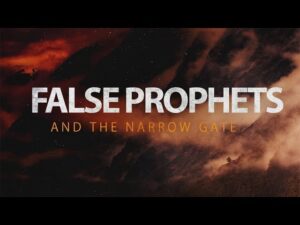Timeline – 1st Century Pillars of Culture
Message recorded live on

Timeline – 1st Century Pillars of Culture

Introduction: Approaching Scripture Historically
Matthew Vander Els from Founded in Truth Fellowship encourages an academic approach to understanding the Bible. While spiritual and religious commentaries offer valuable insights, they can sometimes be rooted in tradition rather than historical evidence. To gain a more accurate understanding of Scripture, it’s beneficial to consider archaeological, anthropological, and historical findings. For example, historical evidence reveals that Dagon was a deity of vegetation, not the fish god as often portrayed in tradition based on a Jewish interpretation of his name’s root. This historical lens is particularly important when studying the Apostle Paul, as understanding the cultural and political context in which he lived and wrote is crucial to grasping the meaning of his letters. Many readers today lack this context, leading to misunderstandings and a tendency to rely on potentially inaccurate interpretations. This teaching aims to provide a foundational timeline of biblical events leading up to the 1st century to better understand the world Paul inhabited.
The Patriarchs: Foundations of the Covenant
The timeline begins around 2000 BCE with Abram, who later became Abraham. Abraham lived in Ur, a Sumerian city in southern Babylonia. God called Abraham to move, eventually leading him to the area of modern-day southern Lebanon. God promised Abraham a vast lineage, numerous descendants, and the land his feet would touch, establishing a significant covenant with him. This covenant was initially a family covenant, where Yahweh was the God of Abraham and his household. The covenant emphasized obedience, and God promised to bless Abraham and his offspring. This lineage continued through Isaac and Jacob, whose name was changed to Israel, meaning “fighting with God.” Jacob had twelve sons, who became the heads of the twelve tribes of Israel.
From Egypt to Canaan: The Formation of a Nation
Joseph, one of Jacob’s sons, was sold into slavery in Egypt but rose to a position of great power. During a famine, Joseph’s brothers and father came to Egypt, and their family grew there. However, a new Pharaoh who did not know Joseph arose and oppressed the Israelites, leading to a period of bondage for about 430 years. In response to their cries, God redeemed them from Egypt in an event known as the Exodus. Instead of immediately entering Canaan, they wandered in the wilderness for approximately 40 years before God led them into the Promised Land under Joshua’s leadership around 1400 BCE. After conquering the land, it was divided among the twelve tribes, except for Levi. The period of the Judges followed, a time marked by various oppressions, including the Moabite oppression during the time of Ruth around 1140 BCE. Samuel the prophet was born around 1100 BCE, during a time of Philistine oppression. The story of Samson and Delilah occurred around 1075 BCE.
The United and Divided Kingdoms: Kingship and Separation
Around 1075 BCE, Israel desired a king like other nations, and Saul became the first king. David was anointed king around 1024 BCE and later reigned over all of Israel after defeating Goliath. David established a united kingdom, which his son Solomon inherited. Solomon built the first temple in Jerusalem around 966 BCE, a permanent dwelling place for God’s glory, replacing the tabernacle. However, after Solomon’s reign, the kingdom divided around 931 BCE. Solomon’s son Rehoboam’s harsh policies led ten of the twelve tribes to break away and form the northern kingdom of Israel under King Jeroboam, while the remaining tribes formed the southern kingdom of Judah. This division was a significant event with lasting consequences. The northern kingdom experienced instability and rebellion against God, exemplified by Jeroboam appointing common people as priests and establishing altars outside Jerusalem. Prophets like Elijah (around 867 BCE) and Hosea (around 760 BCE) warned the northern tribes of their idolatry and disobedience.
Exile and Return: Shaping Religious Practice
In 722 BCE, the Assyrian Empire conquered the northern kingdom of Israel, taking its people into captivity and resettling the land with people from other nations, contributing to the formation of the Samaritans. The southern kingdom of Judah also faced judgment. In 588 BCE, King Nebuchadnezzar of Babylon laid siege to Jerusalem, eventually conquering it, destroying the first temple, and taking the Judeans into exile in Babylon. This period of exile lasted for over 70 years. The absence of the temple, the central focus of Yahwistic faith, led to the development of synagogues as places for fellowship and worship. After the Persian Empire, under Cyrus the Great, conquered Babylon, the Persian king allowed the exiled Jews to return to Judah. Around this time, the second temple, also known as Ezra’s temple, began to be built, though it was less grand than Solomon’s temple. The story of Esther takes place during this Persian period, where many Jews remained in exile.
The Hellenistic and Roman Periods: Cultural Influences
Around the time the second temple was being built, Rome overthrew its kings and established a republic with senators. Meanwhile, the Greek kingdom of Macedonia, under Alexander the Great, expanded rapidly, conquering the Persian Empire, including Judea, around 322 BCE. Alexander’s empire was divided among his generals after his death, and Judea eventually came under the control of the Seleucid Empire. The Seleucid ruler Antiochus Epiphanes around 170 BCE imposed harsh Hellenistic policies, attempting to eradicate Jewish faith and practices. This oppression led to the Maccabean revolt, a successful uprising led by the Hasmonean family, which resulted in the cleansing of the temple and is commemorated by Hanukkah. The Maccabean period saw the rise of different Jewish sects, including the Pharisees, whose name means “to be set apart” from the Gentiles, seeking to preserve Jewish identity and traditions in the face of foreign influence. By 63 BCE, the Roman Empire was expanding and General Pompey captured Jerusalem, bringing Judea under Roman control, though the Hasmoneans continued to rule as vassals. In 40 BCE, Rome appointed Herod, an Edomite who had been converted to Judaism, as the King of Judea.
The Dawn of the First Century: The Roman Empire and the Birth of Yeshua
A significant shift occurred in 27 BCE when Gaius Octavius became Augustus Caesar, the first Roman Emperor, ushering in the Golden Age of the Roman Empire. This era was marked by Roman expansion, patriotism, and the deification of the emperor, creating an “imperial cult.” It was within this powerful Roman context that Yeshua (Jesus) was born in Judea, around 6 BCE to 1 CE. Understanding this historical backdrop is essential for interpreting the New Testament, particularly Paul’s letters, written between 51 and 65 CE. The speaker emphasizes that the faith of Yahweh predates both Christianity and the form of Judaism that developed after the destruction of the second temple in 70 AD, where the Pharisees became the dominant group. Paul’s letters are the oldest parts of the New Testament, offering direct insights into the challenges and context of the early faith in Messiah within the Roman Empire. The question of how Gentiles fit into the Judean faith was a significant issue during Paul’s time. Furthermore, the emphasis Paul placed on the crucifixion of Messiah, even without always immediately mentioning the resurrection in his letters, highlights its central importance to his message within this specific historical and cultural environment.
For more Bible Teachings, click here.
About Founded in Truth Fellowship
Founded in Truth Fellowship is a Messianic Fellowship in Rock Hill, SC that provides Biblical teachings, fellowship, and resources for Biblical studies. Founded in Truth Fellowship is able to spread the gospel and the word of Yeshua because of supporters like you. If Founded in Truth has been a blessing to you or your family, we ask that you would give so that the same messages can bless others.
To give to Founded in Truth Fellowship, click this link: Give to Founded in Truth Fellowship
Founded in Truth Fellowship, 1689 Springsteen Rd, Rock Hill, SC 29730 | (803) 627-8623
Visit our website: https://foundedintruth.com


